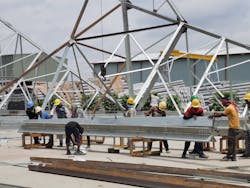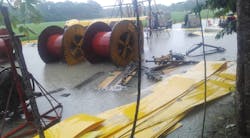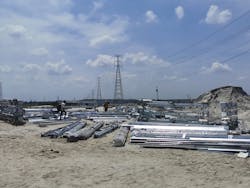Bangladesh Builds 400-kV Transmission System
The fast socioeconomic development in Bangladesh during the last decade has accelerated the demand for energy, leading to the need for substantial investment in the country’s power generation and transmission systems. The power system master plan published in 2016 forecasted an average gross domestic product of 6% for the next 25 years, through 2041. To satisfy this forecast and taking into consideration the demand diversity factor, the estimated system maximum demand will be approximately 72,000 MW, requiring a net generation capacity of at least 79,000 MW by 2041.
As Bangladesh is currently facing a long-term gas crisis, the government is constructing coal-fired power plants to meet the increasing demand for energy. The government’s strategic plan includes establishing several power hubs in the southern part of the country, the first of which was constructed in the vast landscape of Payra. Built by the Bangladesh-China Power Co. Ltd. (BCPCL), the Payra power hub consists of a 1320-MW power plant with two 660-MW generators, located in a village in the Patuakhali district.
The Power Grid Co. of Bangladesh Ltd. (PGCB), the country’s national power transmission utility, had to overcome numerous challenges to complete and commission the Payra hub, including the right-of-way, line route, seasons and extreme weather, topography, supply chain and contractor cash flow.
The First Phase
The first phase of PGCB’s development plan for the Payra hub’s high-voltage transmission system was the need to construct a 400-kV double-circuit transmission line from Patuakhali to Gopalganj.
Following a competitive bidding process, PGCB awarded the contract for construction and commissioning of the 400-kV, 164-km (102-mile) long, double-circuit Patuakhali-Gopalganj transmission line project to GS Engineering & Construction Corp. The designated construction period was 24 months, and the value of the contract was equivalent to US$118 million.
Conductor Selection
To satisfy the specified load-transfer capacity for the 400-kV transmission line, the design team considered a conductor with high-temperature, low-sag (HTLS) characteristics to be critical. From the new generation of overhead line conductors now commercially available, an aluminum composite core conductor (ACCC) was selected.
ACCC can carry up to twice the current of a conventional conductor without causing the excessive line sag that occurs when conventional conductors heat up under increased electrical load conditions. An economic performance analysis confirmed the increased upfront capital cost of using ACCC would be more than offset by the overall project economics over the transmission line’s life cycle.
The ACCC was strung in a quad-bundle configuration (four conductors per phase), with each conductor having a cross-sectional area of 795 sq mm (1.23 sq inch). The current transmission capacity of the double-circuit transmission line is around 1500 MW, somewhat less than the thermal capacity of the circuit, to comply with the transmission system stability limits.
Challenges During Construction
As is common with major capital projects, PGCB had to overcome numerous challenges in constructing the 400-kV Patuakhali-Gopalganj transmission line:
Right-of-way — Securing the right-of-way for construction of the transmission line was the biggest challenge in the project. Local communities and landowners were in opposition to construction work on their land because the compensation offered for the crop, tree and pond damage — in accordance with the prevailing laws — was considerably less than the actual market value. Their higher demands had to be negotiated and fulfilled, sometimes requiring the intervention of local administration and law enforcement agencies, leading to disputes being settled in district courts.
Changes to the line route — In some of the worst cases, landowners deliberately denied access to their land, requiring route changes to sections of the line route. Rerouting of line resulted in more new activities, including the need for surveying, preparing plans and profiles for the new sections, and seeking approval of the same from the design department of PGCB.
Seasonal time frame — In Bangladesh, civil construction works are mostly completed during the dry season — typically from October through March. So, the effective working period was only six months per year. To make the most of this time, about 60 local subcontractors were engaged to undertake foundation works simultaneously.
Construction activities in shallow, marshy land — The dry season is the perfect time for construction activities, but the most difficult task was the transportation of construction materials to tower locations across the vast marshy landscape that stretched along some sections of the transmission line route. Carrying materials was practically impossible as laborers were unable to move on the clay and mud. Even engine-driven boats could not be used, as they grounded to a halt frequently in the shallow water and mud. An alternative method was adopted involving a medium-sized metallic boat that was loaded with materials and dragged manually by an iron rope over the shallow, marshy ground conditions. This tedious method proved very time consuming, causing delays in construction.
Weak supply chain management — Vendors supplying the civil construction materials, cement, sand and stone chips failed to honor their agreements, resulting in delays in construction. Therefore, more additional local suppliers had to be engaged to meet the daily needs of the construction works. A few of these vendors were solely dependent on rental transport, which led to material supply scheduling issues. Improved field management of the material supply chain issues was introduced, resulting in a substantial improvement midway through the project.
Contractor cash-flow problem — The main contractor required to make progress payments to many of the local suppliers and daily laborers experienced cash-flow problems, which led them to seek financial support from PGCB. The subsequent financial agreement between both parties had to be resolved quickly in view of the large financial impact of delays on the project, in terms of capital expenditure overruns and loss of revenue from the delay in commercial operation of the project.
Impact of floods — This 400-kV transmission line crosses four rivers. Therefore, the eight river-crossing towers were planned to be positioned on dry land, based on morphological studies. However, tower erection activities had to be delayed for a few weeks because of flooding and landslides, resulting in the need for additional backfill work that was necessary in the affected areas.
Cyclonic storm — Bulbul, a severe cyclonic storm, crossed Bangladesh during the construction period and lasted four days, causing severe damage and the flooding of village roads and culverts. The open yards used by the contractor to store heavy-duty machines (for example, conductor pullers and cranes) were flooded, resulting in
a two-week delay in all project activities.
Time constraint — The construction period for the project was only 24 months, which ultimately proved to be insufficient to complete the huge volume of tasks:
- Undertake the route survey and complete the plans and profiling
- Construct 461 pile foundations for 400-kV towers, including the foundation for eight large river-crossing towers comprising piles 1000 mm (39.4 inches) in diameter and 55 m (180 ft) in length for each tower
- Construct 50 pile foundations for 132-kV towers
- Complete the erection of the towers having an average height of 60 m (197 ft) and the stringing of conductors on 164-km (102-mile) long transmission line with average span lengths of 350 m (1148 ft)
- Perform testing and commissioning of the 400-kV overhead line circuit.
After overcoming these many challenges, the project team’s reward was the successful completion and commissioning of the 400-kV transmission line, with only a seven-month delay in the originally specified timeline.
Lessons Learned
The dedication, sincerity and professionalism of the engineers and staff members of the main contractor and PGCB’s project management unit (PMU) ensured the success of this major project.
Additionally, the proactiveness of PMU in having quick approval of drawings and designs, running test reports and obtaining swift disbursement of funds from the finance department were instrumental in reducing the implementation time.
Mitigation of the challenges and proactive strategies adopted by PMU have been well documented and were reflected in the project completion report (PCR) to assist future project teams. In addition, the Bangladesh government amended its 19th century Electricity Act because of PGCB’s initiative and continuous efforts by the Line Ministry. As a result of the amended act, it is now easier to secure rights-of-way for the construction of high-voltage overhead transmission lines.
Finally, PGCB acknowledges the full benefit of the Payra power hub will not be achieved until the second section of the 400-kV Payra-Gopalganj-Aminbazar transmission line, namely the 80-km (50-mile) length between Gopalganj and Aminbazar, is commissioned. Construction of this final section of the 400-kV circuit is 95% complete. The largest challenge on this section has been the tower foundation construction for the towers erected in the Padma riverbed.
The termination of this 400-kV circuit is the Aminbazar 400/230-kV substation, equipped with three 520-MVA transformers that will supply the nearby capital city of Dakar, which will then be connected to the Bangladesh high-voltage transmission system.
Acknowledgments
The operational support obtained from the different departments in PGCB — including the grid maintenance divisions, testing and commissioning department, national load dispatch center and many more — were instrumental in the successful implementation of the Patuakhali-Gopalganj transmission line. The author also would like to acknowledge the support and guidance given by the Line Ministry, managing directors and executive director (planning and development) of PGCB in resolving some technical issues and settling numerous contractual disputes.
Md. Shafique Rahman ([email protected]) received his bachelor’s degree in electrical and electronics engineering from the Bangladesh University of Engineering and Technology and his MBA degree from the Bangladesh Open University. Rahman started his career with the Bangladesh Power Development Board as an operation and maintenance engineer in power stations before joining the Dubai Electricity and Water Authority (DEWA) as a power project engineer, where he was awarded for being a distinguished team member of the Dubai government’s excellence program. His career resumed with the Power Grid Co. of Bangladesh Ltd., where he successfully completed numerous transmission line projects prior to being appointed to the position of chief engineer. Currently, Rahman is CEO and director of Green Infrastructure Services Ltd. Based in Dhaka, he is engaged in consultancy projects on infrastructure development in the power sector.
About the Author
Md. Shafique Rahman
Shafique Rahman ([email protected]) received his bachelor’s degree in electrical and electronics engineering from the Bangladesh University of Engineering and Technology and his MBA degree from the Bangladesh Open University. Rahman started his career with the Bangladesh Power Development Board as an operation and maintenance engineer in power stations before joining the Dubai Electricity and Water Authority (DEWA) as a power project engineer, where he was awarded for being a distinguished team member of the Dubai government’s excellence program. His career resumed with the Power Grid Co. of Bangladesh Ltd., where he successfully completed numerous transmission line projects prior to being appointed to the position of chief engineer. Currently, Rahman is CEO and director of Green Infrastructure Services Ltd. Based in Dhaka, he is engaged in consultancy projects on infrastructure development in the power sector.




